Cottage cheese dry curd recipes don’t get the spotlight—but they should. Dry curd’s clean bite, subtle tang, and low-moisture versatility make it a sleeper hit in smart kitchens. Whether you’re ditching lactose, chasing high-protein goals, or cooking from the food bank shelf, this cheese punches way above its weight. Below, we’ll break down a creamy baked bowl that proves just how practical and downright craveable this ingredient can be.
Table of Contents
Why Dry Curd Cottage Cheese Is Worth Cooking With
If you’ve ever opened a tub of dry curd cottage cheese and thought, “Now what?”, you’re not alone. Most If you’ve ever opened a tub of dry curd cottage cheese and thought, “Now what?”, you’re not alone. Most grocery store recipes skip right over this ingredient. But dry curd—also called farmer’s cheese or baker’s cheese—has earned its place in the kitchen. It’s lactose-light, high in protein, and works beautifully in both savory and sweet dishes when handled right.
What Is It, Really?
Dry curd cottage cheese is just what it sounds like: the curds of regular cottage cheese, but without added cream or liquid. It’s crumbly, mild, and a bit tangy. You won’t get the creamy scoopable texture you see in large curd cottage cheese, but that’s part of the appeal—it’s versatile and easily customized.
And it’s not just about texture. The drier nature of these curds makes them perfect for recipes where moisture balance matters, like:
- Baked pancakes or fritters
- Pasta fillings and casseroles
- No-soggy breakfast bowls
In fact, our flourless cottage cheese pancakes are inspired by this exact balance of protein and structure.
Why Use It Instead of Regular Cottage Cheese?
Think of it as the ricotta of the cottage cheese world—firmer, less wet, and more adaptable in baking. If you’re trying to cut lactose or simply got dry curd from a food pantry or a local co-op, it’s a great substitute in recipes that typically call for cheese blends.
It also holds up well in reheated meal prep. I use it often in layered dishes or stuffed sweet potatoes like this cottage cheese sweet potato bowl, because it won’t turn watery or grainy after a few days in the fridge.
Quick Uses Before We Dive Into the Recipe
Here are some fast ways to use dry curd cottage cheese before it goes to waste:
- Blend with Greek yogurt and herbs for a high-protein dip
- Add to scrambled eggs or omelets
- Mix it into roasted sweet potatoes and finish with a drizzle of hot honey and a dash of cinnamon
- Use in place of feta or ricotta in salads or bowls
One of my go-tos? A quick mash with roasted carrots and olive oil—perfect alongside this carrot ribbon salad for a plant-forward lunch.
Creamy Baked Bowl with Dry Curd Cottage Cheese
This warm, savory cottage cheese bowl is one of my go-to recipes when I want something simple, reheatable, and high-protein—without relying on cream or heavy cheeses. The secret? Dry curd cottage cheese layered with tender roasted vegetables and a whipped egg mixture that binds it all into something surprisingly satisfying.
Ingredients
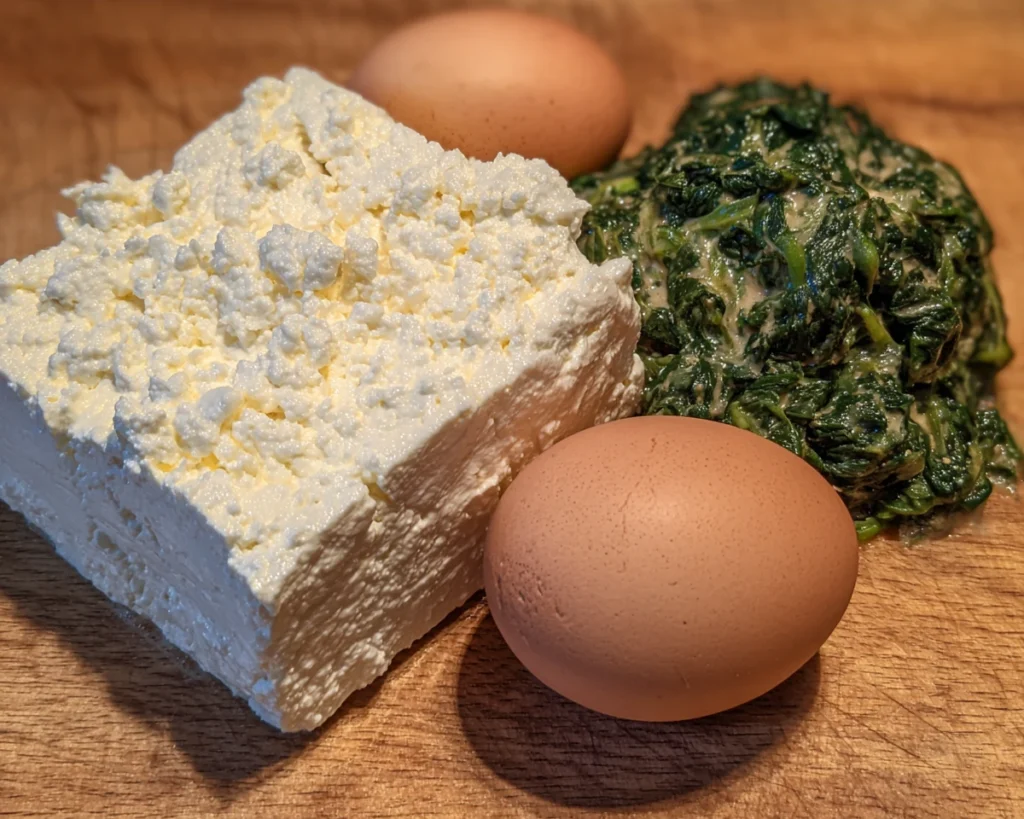
Here’s everything you need for two filling servings:
- 1 cup dry curd cottage cheese
- 2 large eggs
- 1 tablespoon olive oil
- 1/2 cup chopped cooked spinach (frozen or fresh)
- 1/4 cup chopped green onion
- 1/2 teaspoon garlic powder
- 1/2 teaspoon smoked paprika
- Salt and pepper to taste
- Optional: 2 tablespoons plain Greek yogurt (for moisture)
Optional Add-Ins:
- A handful of roasted sweet potato chunks for natural sweetness (see this sweet potato protein bowl for inspiration)
- A bit of sauerkraut or kimchi if you like tangy brightness
- Diced turkey sausage or mushrooms for an umami boost
Step-by-Step Instructions
Step 1: Preheat & Prep.
Set your oven to 375°F (190°C). Lightly grease a small casserole dish or two ramekins with olive oil.
Step 2: Mix the Base.
In a bowl, combine the dry curd cottage cheese, eggs, olive oil, spinach, green onion, and spices. If the texture feels a little stiff, add a spoonful of Greek yogurt to bring everything together.
Step 3: Pour & Bake.
Transfer the mixture to your prepared dish and bake for 25–30 minutes. You’ll know it’s ready when the edges are golden and the center feels set when lightly pressed.
Step 4: Rest and Serve.
Let it cool for 5–10 minutes before digging in. This short rest gives the bake time to settle, making it easier to portion or store for later.
It’s a recipe that works both warm and cold. I often plate it alongside something crisp and vibrant like this retinol carrot salad—especially if I’m packing lunch for tomorrow.
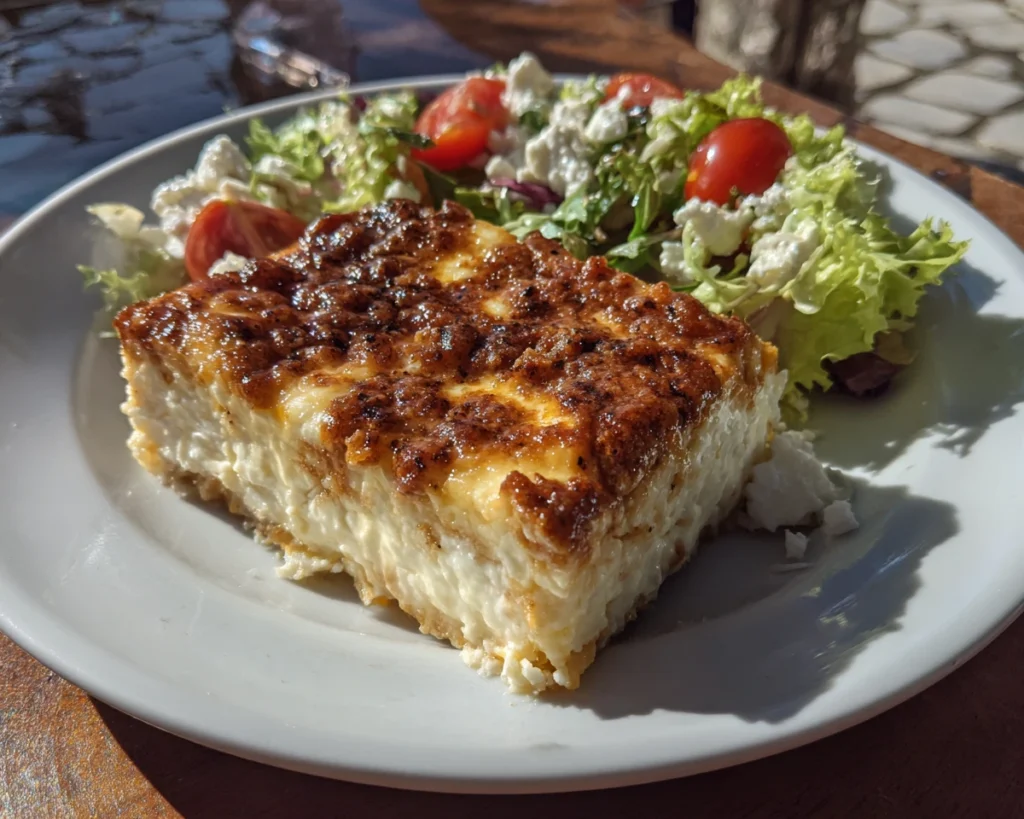
Creamy Baked Bowl with Dry Curd Cottage Cheese
When it comes to practical cottage cheese dry curd recipes, this baked bowl is one I keep coming back to. It’s protein-packed, easy to prep ahead, and doesn’t rely on cream or stretchy cheeses to feel satisfying. The texture of dry curd holds everything together without turning soggy—perfect for reheating or eating cold.
Ingredients
This simple mix gives you two generous servings:
- 1 cup dry curd cottage cheese
- 2 large eggs
- 1 tablespoon olive oil
- 1/2 cup chopped spinach (lightly cooked or thawed frozen)
- 1/4 cup green onion
- 1/2 teaspoon garlic powder
- 1/2 teaspoon smoked paprika
- Salt and black pepper to taste
- Optional: 2 tablespoons plain Greek yogurt
Optional Add-Ins:
- Chunks of roasted sweet potato (a great way to use leftovers from this sweet potato protein bowl)
- A scoop of kraut or fermented veggies
- Chopped cooked turkey sausage or sautéed mushrooms
Step-by-Step Instructions
Step 1: Preheat and Prepare.
Heat your oven to 375°F (190°C). Lightly coat a small baking dish or a couple of ramekins with olive oil to prevent sticking.
Step 2: Combine Ingredients.
In a bowl, mix the dry curd cottage cheese, eggs, olive oil, spinach, green onion, and spices. If the mixture feels too stiff, stir in Greek yogurt to help bind and soften—an easy fix if you’re wondering how to moisten dry curd cottage cheese.
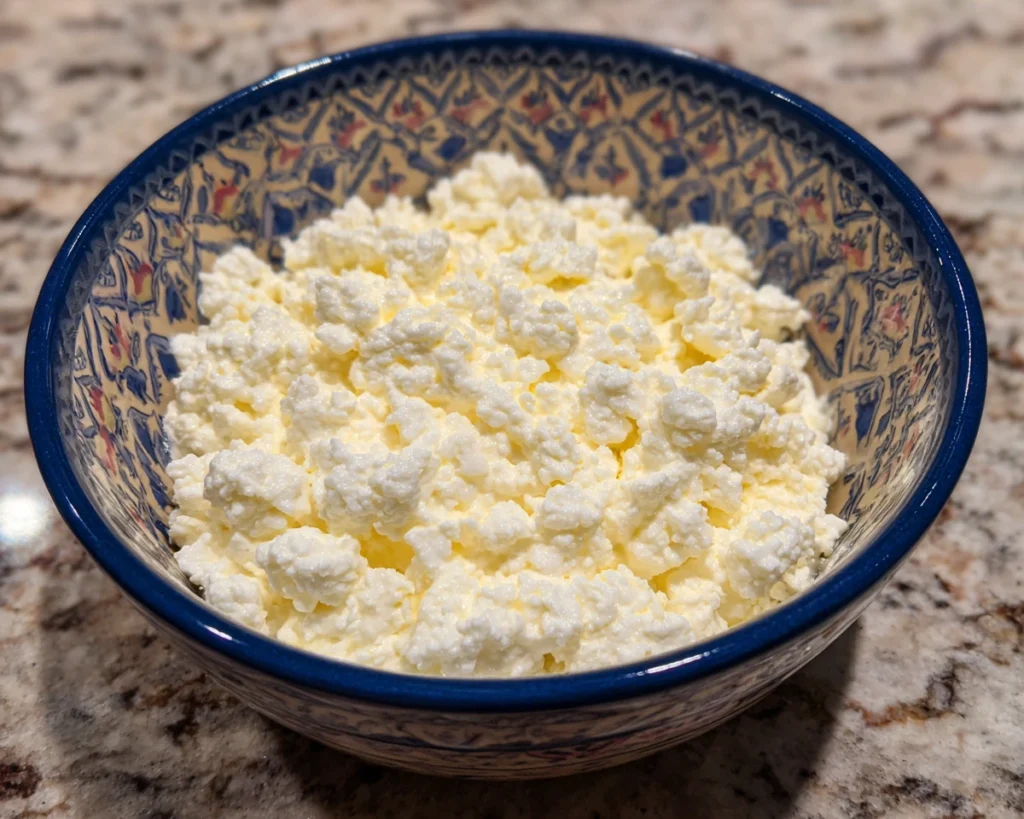
Step 3: Bake It.
Spoon the mixture into your prepared dish. Bake for about 25–30 minutes. The top should brown slightly, and the center should hold its shape when nudged gently.
Step 4: Let It Rest.
Allow the dish to cool for 5–10 minutes before serving. It firms up slightly as it sits, making it easier to portion—and even better the next day.
Among cottage cheese dry curd recipes, this one stands out because it keeps its structure and reheats beautifully. I love pairing it with a chilled, crunchy side like retinol carrot salad to balance the richness.
Print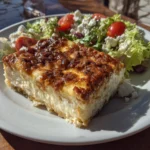
Cottage Cheese Dry Curd Recipes That Work – 5 Great Ideas
- Total Time: 40 minutes
- Yield: 2 servings 1x
Description
A savory baked bowl using dry curd cottage cheese, spinach, and eggs—great for meal prep or a simple high-protein breakfast.
Ingredients
- 1 cup dry curd cottage cheese
- 2 large eggs
- 1 tablespoon olive oil
- 1/2 cup chopped cooked spinach
- 1/4 cup chopped green onion
- 1/2 teaspoon garlic powder
- 1/2 teaspoon smoked paprika
- Salt and pepper to taste
- Optional: 2 tablespoons plain Greek yogurt
Instructions
- Preheat oven to 375°F (190°C) and lightly coat a small baking dish or ramekins with olive oil.
- In a bowl, mix dry curd cottage cheese, eggs, spinach, green onion, oil, and seasonings. Add yogurt if needed to moisten.
- Transfer mixture to dish and bake for 25–30 minutes, until set and golden around the edges.
- Let rest for 5–10 minutes before serving or storing.
Notes
- Optional add-ins: sweet potato chunks, turkey sausage, or kimchi.
- Best served warm, but holds up well as a cold lunch.
- To rehydrate dry curd, stir in Greek yogurt or a splash of olive oil.
- Prep Time: 10 minutes
- Cook Time: 30 minutes
- Category: Meal Prep
- Method: Baked
- Cuisine: American
Nutrition
- Serving Size: 1 bowl
- Calories: 220
- Sugar: 2g
- Sodium: 420mg
- Fat: 12g
- Saturated Fat: 4g
- Unsaturated Fat: 7g
- Trans Fat: 0g
- Carbohydrates: 5g
- Fiber: 1g
- Protein: 21g
- Cholesterol: 185mg
Keywords: cottage cheese dry curd recipes, baked cottage cheese, high protein breakfast, Cottage cheese, sour cream, egg yolk noodles, dairy, sea salt
What to Eat With Dry Curd Cottage Cheese Bowls
One reason I keep coming back to cottage cheese dry curd recipes like this baked bowl? They’re easy to dress up or down depending on what’s in your fridge. You can serve it hot or cold, and it plays well with a bunch of different textures—crispy, creamy, tangy, or fresh.
Bowls That Balance Texture
Dry curd cottage cheese is neutral enough to support bold flavors without overpowering them. Here are a few combinations that just work:
- Roasted vegetables and sharp vinaigrettes: Think crispy Brussels sprouts, red onion, or even grilled carrots. Try it with our retinol carrot salad for a color and nutrient boost.
- Pickled or fermented sides: A spoonful of kraut or pickled red cabbage can cut through the richness and bring balance.
- Fresh greens: Arugula or baby kale with lemon juice is a nice bitter contrast to the creamy curds.
Protein Pairing Ideas
Since many cottage cheese dry curd recipes are already protein-rich, you don’t need much to complete the plate. But if you’re building out a prep plan, try:
- A soft-boiled egg and avocado on the side
- A scoop of this high protein taco bowl for a Tex-Mex angle
- Roasted chickpeas or lentils for a plant-based pairing
Breakfast or Lunch?
This baked cottage cheese bowl is flexible. At breakfast, I like to add hot sauce or a dollop of Greek yogurt on top. For lunch, I’ll often pack it cold with a crunchy raw salad like our carrot ribbon salad.
And if you’re batch prepping, dry curd holds up way better than regular cottage cheese. It won’t get watery or break down by day two—making it one of the most reliable ingredients in my cottage cheese dry curd recipes rotation.
Common Questions About Cottage Cheese Dry Curd Recipes
What is dry curd cottage cheese used for?
Dry curd cottage cheese is used in both sweet and savory dishes where moisture control matters. It’s popular in casseroles, low-lactose baking, pasta fillings, and high-protein breakfast bowls. Many cottage cheese dry curd recipes rely on it for its mild flavor and firm texture. We’ve even used it in our cottage cheese pancakes to replace flour and add structure.
Can you melt cottage cheese curds?
Not really. Dry curd cottage cheese doesn’t melt the way mozzarella or cheddar does. That’s why cottage cheese dry curd recipes usually bake it into dishes rather than using it for gooey textures. Think of it more like ricotta—it softens when heated but holds its form. For a meltier result, blend it with yogurt or mix into a creamy sauce base.
What is the difference between cottage cheese and dry curd cottage cheese?
Regular cottage cheese includes added cream or milk, giving it a creamy, scoopable texture. Dry curd cottage cheese is pressed and drained, so it’s drier, crumbly, and lower in lactose. If you’re experimenting with cottage cheese dry curd recipes, this difference matters—especially in baking, where too much moisture can throw off the structure.
How to moisten dry curd cottage cheese?
The easiest fix is to stir in a bit of plain Greek yogurt, sour cream, or even olive oil. Some cottage cheese dry curd recipes also call for milk or beaten eggs to bring the curds back to a softer state. In our baked bowl recipe above, we use yogurt and eggs to rehydrate the curds without making the dish watery.
Conclusion: The Case for Cooking with Dry Curd
There’s a reason cottage cheese dry curd recipes are quietly making a comeback—they’re practical, flexible, and surprisingly satisfying when you know how to work with the ingredient. Whether you’re baking a protein-packed lunch bowl, stuffing sweet potatoes, or mixing a no-fuss breakfast, dry curd cottage cheese brings structure without heaviness.
If you’re new to it, start with our creamy bake—it’s the kind of dish you can tweak endlessly. Then branch out. Try tossing curds into your sweet potato bowl, folding them into omelets, or pairing with punchy sides like our high protein taco bowl or carrot ribbon salad.
And remember—moisture is the variable. With a little yogurt or olive oil, you can turn any of your favorite dishes into reliable, reheatable cottage cheese dry curd recipes that don’t fall apart by day three.
Need more ideas? Browse more protein-packed meals and practical bowls over at Skinnytaste or dig into prep tips on Pinterest.
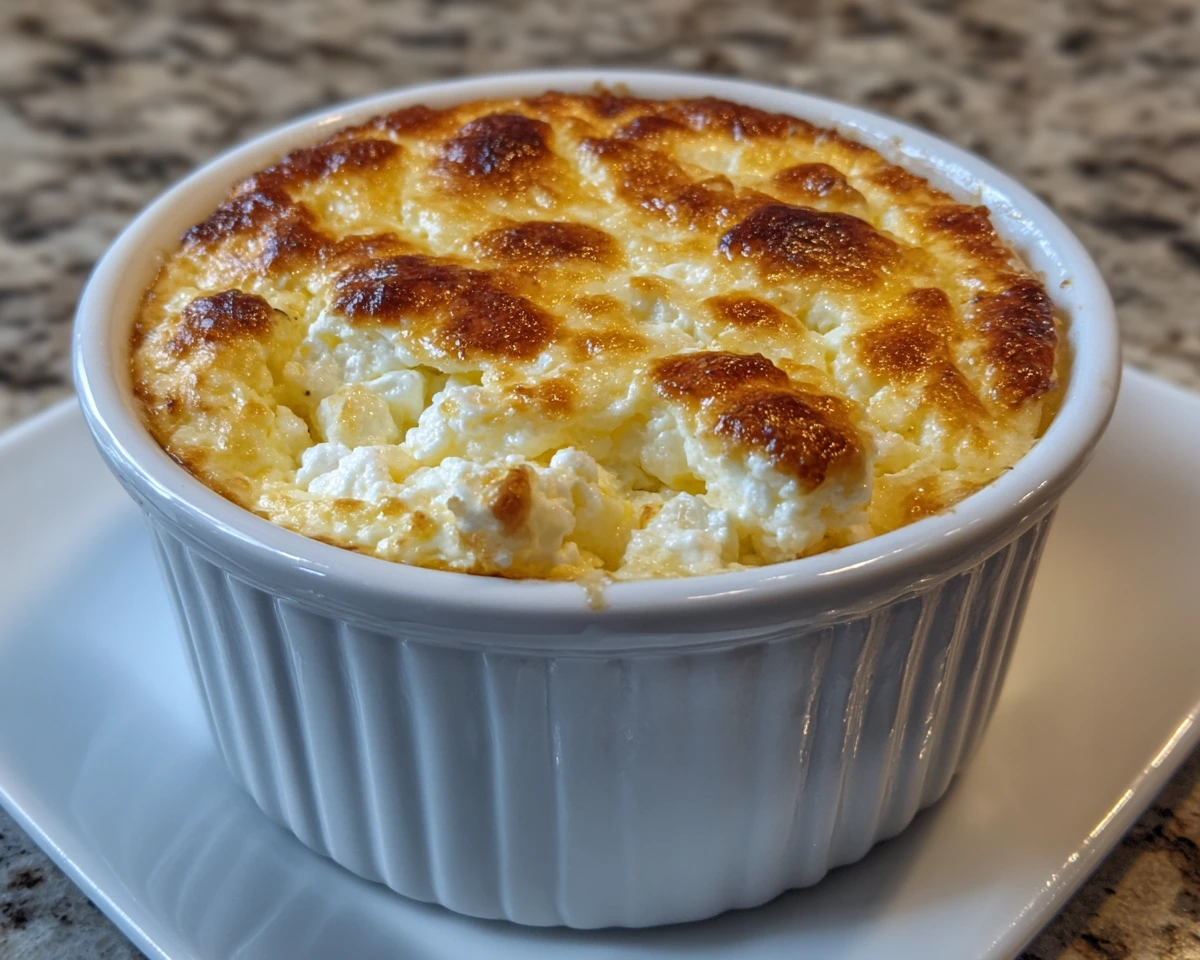
This was my first time cooking with dry curd and I’m surprised how well it turned out. The baked bowl was perfect for weekday lunches—super easy to reheat!
Loved the balance of flavor without using any heavy cheese. The notes on moisture helped a lot—adding yogurt made it just right.
This guide made dry curd cottage cheese way less intimidating. I’ve already made the recipe twice and even added hot sauce and roasted carrots—so good.
Super helpful article! I had a huge block of dry curd from a bulk order and no clue what to do with it. The baked version is now a go-to.